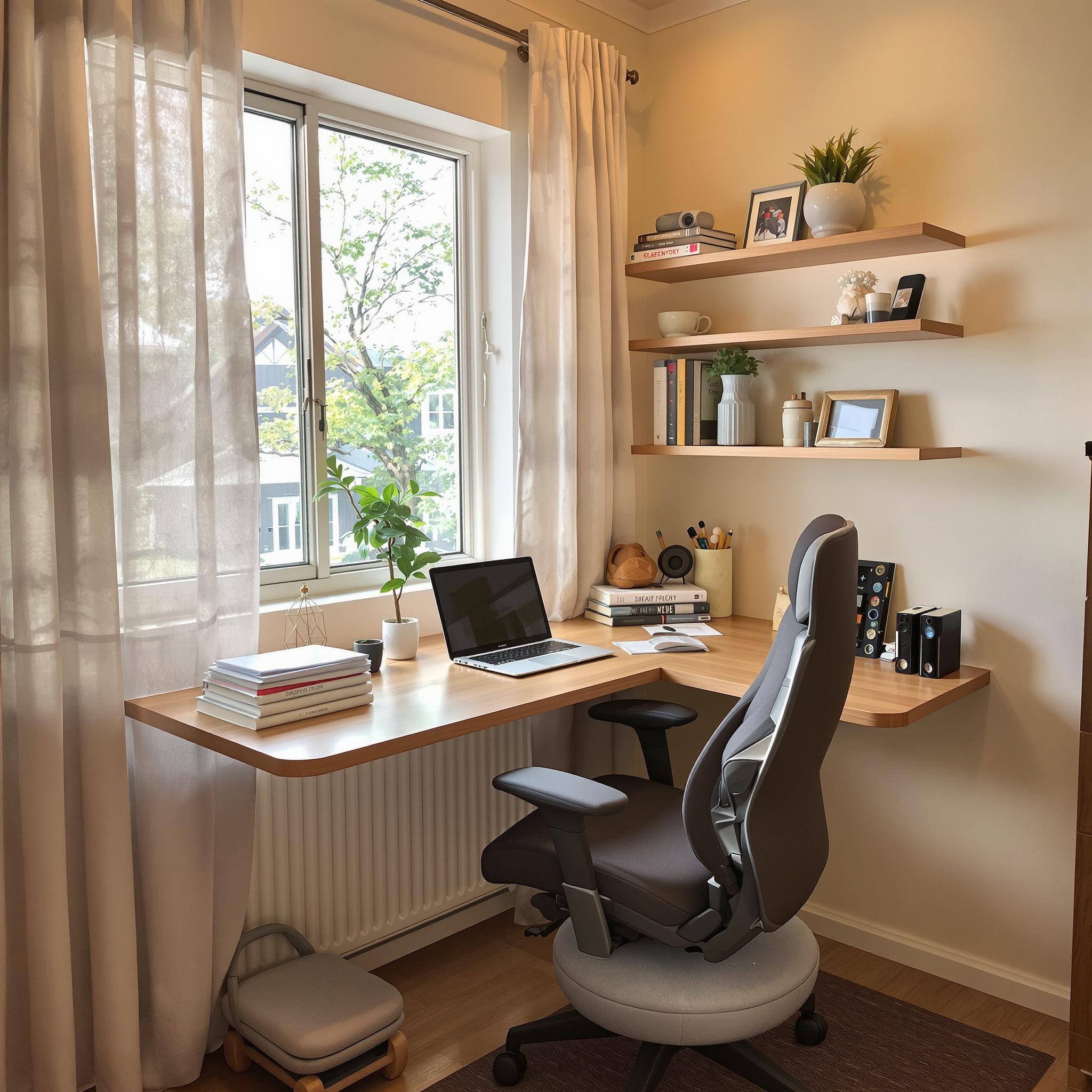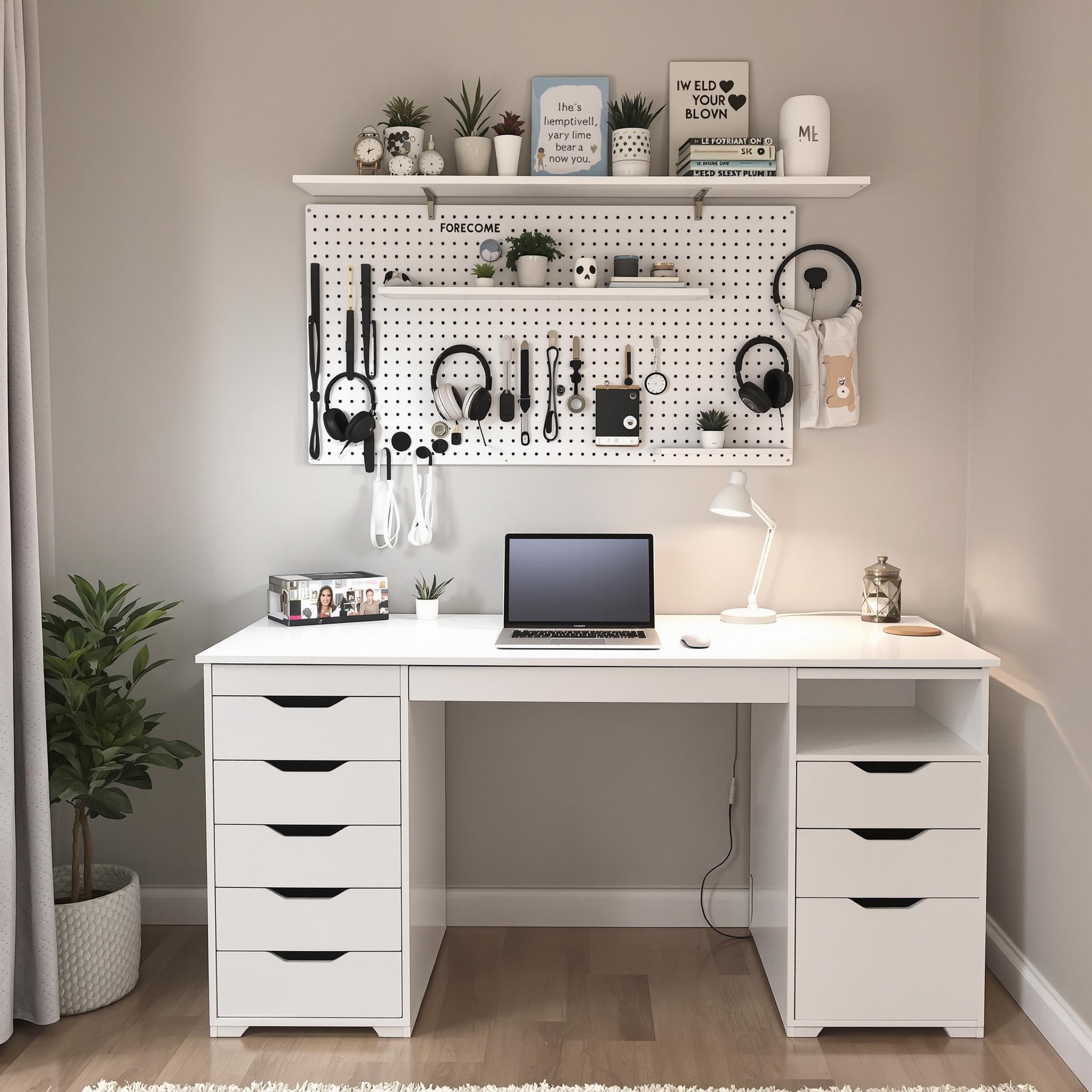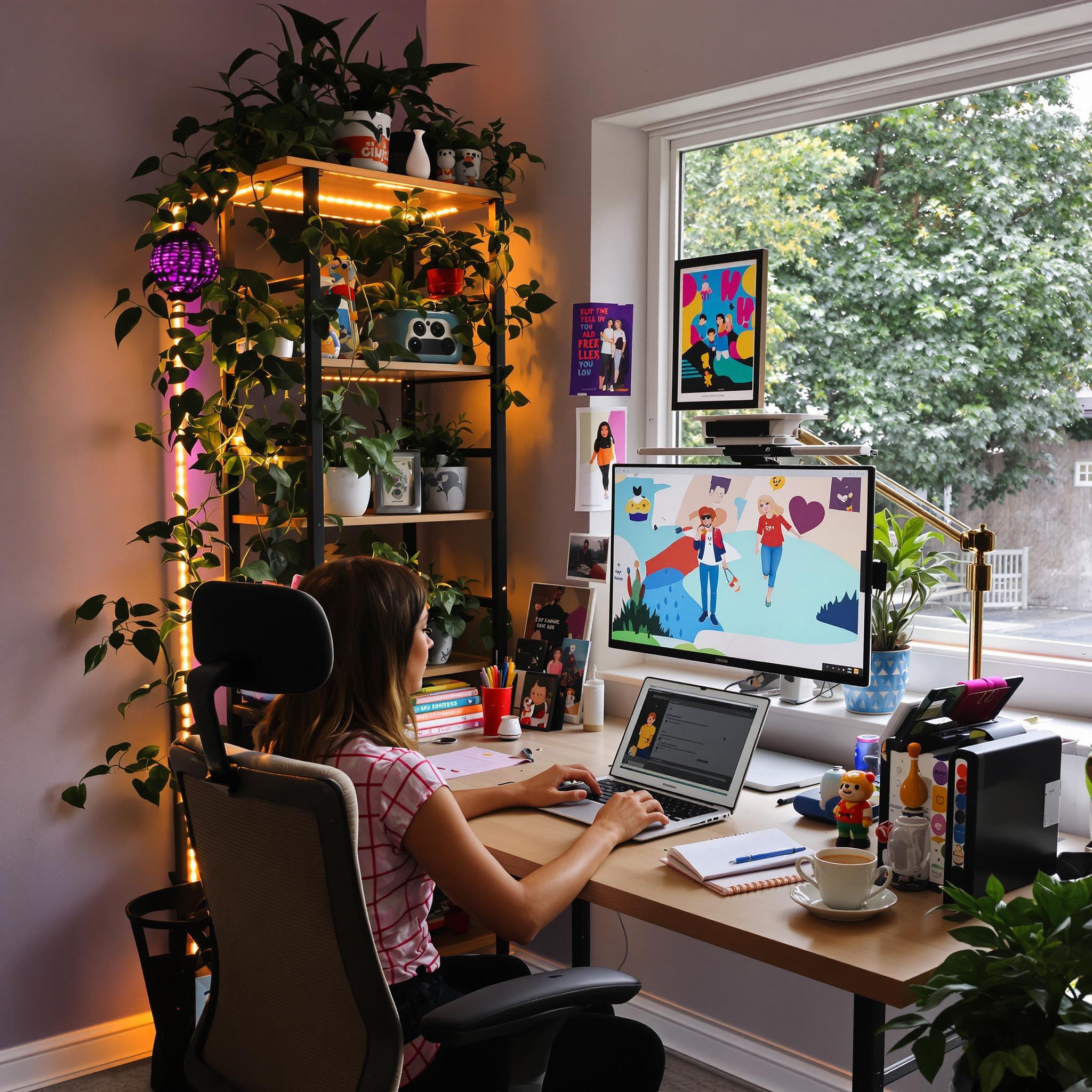Challenges of Small Home Office Spaces
Working in a small home office can feel frustrating. Limited space is often the biggest issue. You might struggle to fit everything you need. A desk, chair, and storage can quickly overwhelm the area. Clutter builds up fast when there’s no room to organize.
Lack of storage creates another challenge. Papers pile up. Supplies get lost. Without proper solutions, your workspace becomes chaotic. This makes it hard to focus and stay productive.
Poor ergonomics is another common problem. Many people use furniture that doesn’t support good posture. A chair that’s too low or a desk at the wrong height leads to discomfort. Over time, this causes strain on your back, neck, and wrists.
Noise can also be a big distraction. If your office shares space with other rooms, sounds from family or pets interrupt your work. Even appliances like washing machines add unwanted noise.
Key Factors for Designing a Functional Workspace
Planning your layout is essential. Start by measuring your space. Decide where each item will go. Place your desk near natural light if possible. Keep frequently used items within arm’s reach.
Lighting plays a huge role in comfort and productivity. Poor lighting strains your eyes and makes work harder. Use a mix of natural and artificial light. Add a desk lamp if overhead lights aren’t enough. Choose bulbs that mimic daylight for better focus.
Noise reduction strategies help create a calm environment. Use rugs or curtains to absorb sound. Consider a white noise machine to block out distractions. Earplugs work well for louder spaces.
Tips for Maximizing Space in a Small Office
Vertical storage saves valuable floor space. Install shelves or wall organizers. They hold books, files, and supplies without taking up room. Floating shelves are sleek and practical.
Furniture with dual purposes is ideal. Look for desks with built-in drawers or storage compartments. Some chairs even have hidden storage underneath. These options keep clutter under control.
Think about foldable or collapsible furniture. A foldable desk can be tucked away when not in use. This works well if your office doubles as a guest room or living area.
Ergonomic Solutions for Comfort
Invest in a quality chair. It should support your lower back and allow your feet to rest flat on the floor. Adjustable features let you customize the height and tilt.
Your desk height matters too. Your elbows should form a 90-degree angle when typing. If your desk is too low, use risers or a keyboard tray. For laptops, consider a stand to bring the screen to eye level.
Add accessories for extra comfort. A footrest helps if your feet don’t reach the floor. A wrist pad reduces strain while using a mouse or keyboard. These small changes make a big difference over time.
Personal Insights on Small Office Design
I once worked in a tiny corner of my apartment. At first, I felt cramped and disorganized. Then I added shelves above my desk. Suddenly, I had space for all my books and files. The change was simple but transformative.
Lighting also made a huge impact. I swapped a dim desk lamp for a bright LED one. My eyes stopped feeling tired after long hours of work. Small upgrades like this boost both mood and efficiency.
For noise, I tried different solutions. Thick curtains blocked outside sounds. A fan provided steady white noise. These tricks turned my chaotic space into a peaceful retreat.
Practical Steps to Get Started
Begin by decluttering your office. Remove anything you don’t use daily. Donate old supplies or store them elsewhere. A clean slate makes planning easier.
Create a priority list. What do you need most? Focus on essentials like a desk, chair, and storage. Add decorative items later. Function comes before style.
Test your setup before finalizing it. Spend a day working in the new arrangement. Notice what feels comfortable and what needs tweaking. Adjustments ensure your space truly works for you.
- Measure your space before buying furniture.
- Choose multi-functional pieces to save room.
- Use vertical storage to free up floor space.
- Incorporate ergonomic tools for long-term comfort.
A small home office doesn’t have to feel limiting. With smart planning, you can create a workspace that’s both functional and inviting. Every detail matters, from layout to lighting. Take your time to design a space that supports your work and well-being.
Multi-Functional Furniture: The Swiss Army Knife of Your Home Office
Let’s be real—small spaces need smart solutions. When space is tight, multi-functional furniture becomes a lifesaver. I remember setting up my first home office in a cramped corner of my studio apartment. I had this bulky desk that hogged way too much room. Storage? Forget it. Then one day, while scrolling online (probably avoiding work), I found desks with built-in storage. Total game changer.
These desks are like having a personal assistant minus the awkward chit-chat. Drawers and shelves let you stash pens, sticky notes, chargers, and more. No more clutter staring you down. If you’re into notebooks, look for models with dedicated slots. It’s oddly satisfying to know where everything lives.
Funny enough, some desks now double as standing desks. You can adjust the height to sit or stand. Trust me, your back will appreciate it after hours of spreadsheets. Wall-mounted desks are another great option. They fold down when needed and vanish when not—a clever space-saving trick.
Vertical Organization: Think Up, Not Out
Most people organize horizontally, but vertical is where it’s at. Walls are free real estate waiting to be used. Imagine lifting piles of papers, files, and books off your desk and onto the walls. Sounds nice, right?
Shelves are an obvious fix, but they don’t have to be boring. Floating shelves give you storage without taking up visual space. Add plants, photos, or quirky items to make them personal. I once hung a shelf above my desk just for coffee mugs. It saved drawer space and became a mini gallery of caffeine vibes.
Pegboards are another smart choice. These boards let you hang folders, headphones, cables—you name it. My pegboard saves me headaches. I used to lose my laptop charger constantly. Now it hangs neatly within reach. Bulletin boards are handy too. Pin up reminders or quotes, but don’t go overboard. You don’t want it looking like a teenager’s mood board from 2005.
Cable Management: Taming the Tech Jungle
Raise your hand if your desk looks like a bowl of tangled spaghetti. Mine does. Cable management might sound dull, but it’s worth it. Once you tidy those wires, your setup feels cleaner and more pro.
Start with cable ties or zip ties. They’re cheap and easy to use. Bundle similar cords together—like USBs or power adapters—and label them if needed. Pro tip: color-coded labels help you spot which cord goes where. I once wasted 10 minutes figuring out my monitor’s cord. Never again.
For a sleeker vibe, try cable sleeves. These tubes wrap around multiple wires, turning chaos into a single bundle. Mounting clips or adhesive hooks can route cables along desk edges or walls. Hide them behind furniture or in cable boxes. Out of sight, out of mind.
Wireless tech is perfect for small spaces. Swap wired keyboards and mice for wireless versions. Same goes for printers—compact wireless models save space and ditch extra cords. Portable printers are great too. Perfect for scanning receipts or printing last-minute docs without hogging desk space.
Technology Integration: Smart Tools for Tiny Spaces
Now, let’s talk tech. It’s a lifesaver in small offices because it helps you do more with less. Wireless devices are a prime example. Remember Ethernet cables snaking across the floor? Gone. Wi-Fi routers and mesh systems deliver strong signals without the clutter.
Smart assistants like Alexa or Google Nest boost productivity. Need reminders, meeting schedules, or background tunes? Just ask. Funny story: I asked my smart speaker to remind me to water my plant. It said, “Sure thing!” Now my snake plant thrives. Who knew tech could be so green?
When it comes to gear, think compact. Laptops are smaller than desktops, freeing up desk space. For dual monitors, try ultra-thin displays that mount on the wall. Cloud storage is another win. Storing files digitally cuts down on paper clutter.
Here’s a fun idea: use apps to declutter your digital life too. Password managers keep logins secure without sticky notes everywhere. Tools like Trello or Asana help organize tasks. I started using them to stay on top of deadlines, and now I’m hooked. It’s like having a virtual assistant whispering reminders.
Final Thoughts Before Wrapping Up
Quick recap: multi-functional furniture saves space and sanity. Vertical organization uses unused areas. Cable management keeps things neat. Smart tech streamlines your workflow. But honestly, the key is finding what works for YOU. Everyone’s setup is unique, like snowflakes or avocado toast recipes.
One last thought: take your time. Rome wasn’t built in a day, and neither is a perfect home office. Start small, experiment, and tweak as needed. Over time, you’ll create a space that’s functional, stylish, and uniquely yours. If you feel overwhelmed, step back, grab coffee, and remind yourself—it’s all part of the process.
Creating a Productivity-Boosting Environment in Your Compact Workspace
Let’s talk about making your small workspace more productive and comfy. When I first started working from home, my desk was basically a TV tray crammed into a bedroom corner. Not exactly inspiring. But small changes can make a big impact. If you’re still using a dining chair as your office chair, we need to fix that.
Ergonomics is one of those words people toss around, but it really matters. Picture this: you’re hunched over your laptop like Gollum guarding his ring. It hurts after a while and drains your energy fast. Here’s what you can do:
- Desk Height: Your desk should let your elbows form a 90-degree angle when typing. If your desk is too low, use a keyboard tray or stack some books.
- Chair Selection: A good chair isn’t just for Zoom calls—it supports your back. Look for lumbar support, adjustable height, and armrests. Test it out before buying.
Your body will thank you later. Don’t overlook standing desks either. I got one last year, and it’s been great. Just switch between sitting and standing. Standing all day feels like doing squats all afternoon.
Adding Life and Personality to Your Space
Now, let’s brighten things up. Ever walked into a room so bland it felt like a dentist’s office? That vibe doesn’t spark creativity. Adding greenery or personal touches can transform your space. Here’s how:
- Plants: They’re not just nice to look at—they clean the air and lower stress. Try easy plants like snake plants or pothos if you kill everything green (like me).
- Personal Touches: Add family photos, artwork, or quirky items. My favorite? A mini bobblehead of myself. Hard not to smile at that.
Funny story—I once had a colleague who decked her cubicle with Star Wars stuff. At first, I thought she was crazy, but it made her happy every day. Surround yourself with things you love, even if they’re a bit offbeat.
And don’t forget lighting. Natural light is best, but if you’re stuck without windows, get a good lamp with warm tones. Harsh fluorescent lights are a mood killer.
Routines That Keep You Focused and Motivated
Alright, now let’s talk routines. Even the coziest workspace won’t save you from distractions or burnout without a plan. Routines give structure to chaos, especially in tight spaces where everything feels cramped.
First, set boundaries. Designate work hours or separate your workspace from living areas. I use noise-canceling headphones to signal focus time. It works surprisingly well.
Next, take breaks. Short pauses boost productivity more than grinding all day. Try the Pomodoro Technique: 25 minutes of work, then a 5-minute break. Stretch, grab a snack, or check cat memes. Do whatever relaxes you.
Here’s another idea—schedule “me time.” Journal, meditate, or stare out the window. Recharging is key. My go-to? A mid-afternoon tea break and a quick walk outside. Simple, but effective.
Final Thoughts: Small Space, Big Impact
At the end of the day, improving productivity and comfort in a small workspace comes down to balance. Get ergonomic basics, add personal touches, and stick to routines that keep you sharp. Your setup doesn’t need to be perfect—it just needs to work for you. Take a deep breath, embrace your cozy corner, and watch your efficiency climb.
Frequently Asked Questions
- How can I maximize space in a small home office?
Use shelves or wall organizers. Declutter regularly to keep only essentials. - What’s the best type of chair for long hours at a desk?
Go for an ergonomic chair with adjustable features. Brands like Herman Miller or Steelcase are solid choices. - Can plants really boost productivity?
Yes. Plants reduce stress and help you focus. Plus, they add color to dull spaces. - How often should I stand if I use a standing desk?
Switch every 30–60 minutes. Standing all day gets tiring, so mix it up. - Is natural light better than artificial light?
Yes, natural light lifts your mood. Good LED lamps mimic daylight and work well too. - What are some quick ways to personalize my workspace?
Add framed photos, colorful notebooks, or fun accessories. A scented candle helps too. - How do I avoid distractions in a shared space?
Set boundaries with others. Use white noise machines or apps like Focus@Will. - Why is routine important for productivity?
Routine creates consistency and cuts decision fatigue. Knowing what’s next keeps you on track. - Should I upgrade my monitor for better productivity?
If possible, yes. A bigger or dual-monitor setup helps multitask and reduces eye strain. - How can I stay motivated in a small workspace?
Keep goals visible, celebrate wins, and refresh your space. Rearranging furniture gives a fresh feel.



